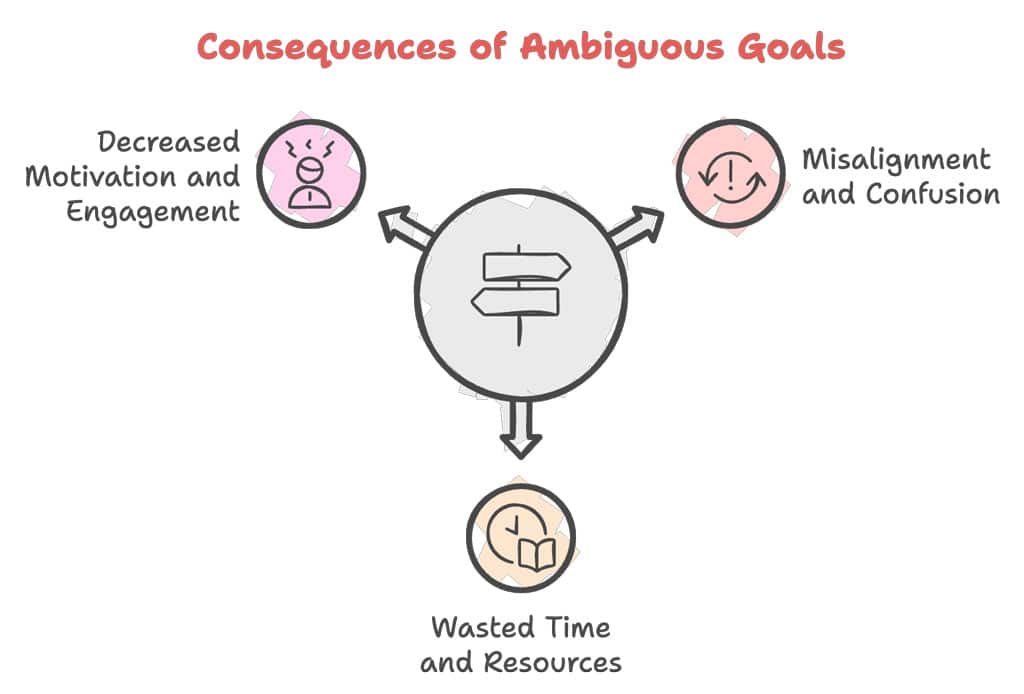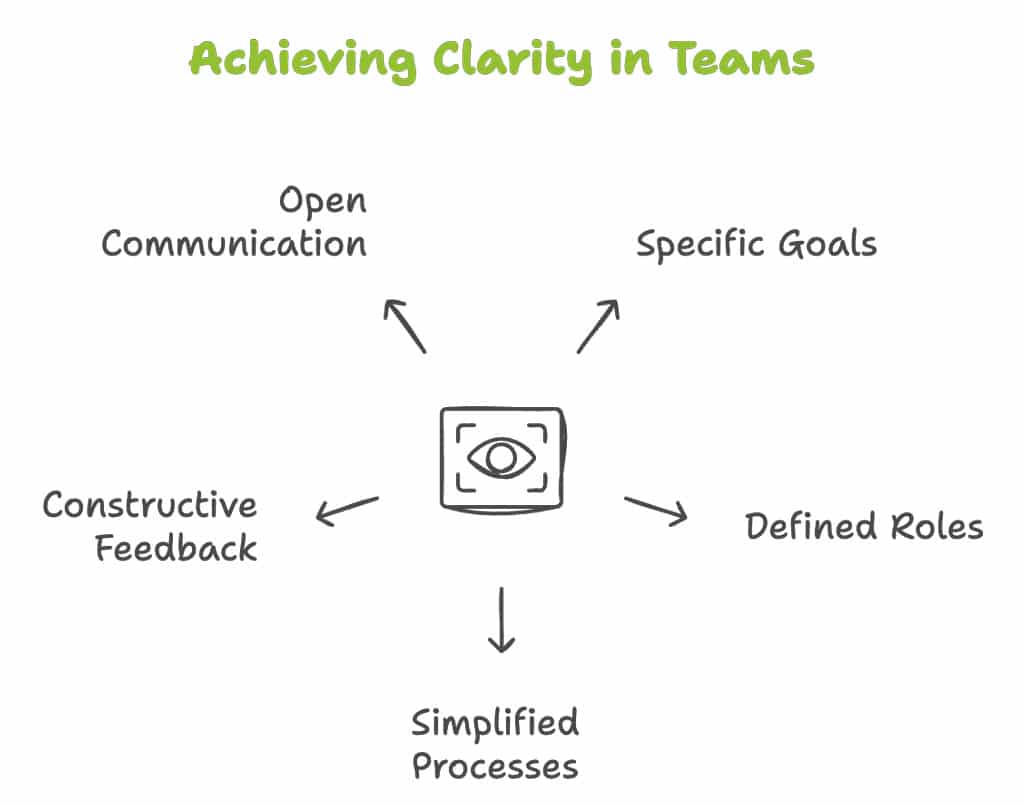Clarity vs. Ambiguity: The True Cost of Unclear Goals in the Workplace

In leadership, we’re constantly aiming for success, productivity, and growth. But there’s one silent productivity killer that stands in the way more than most leaders realize: ambiguity. Ambiguous goals, vague instructions, and murky expectations are like sand in the gears of any organization. They slow things down, cause friction, and, over time, they grind performance to a halt.
Without clarity, even the best teams can become misaligned, demotivated, and unfocused. Teams are left in the dark, guessing what success looks like and often working hard—just on the wrong things. So, let’s break down why clarity is the foundation of productive work and how leaders can steer clear of ambiguity to create an engaged, high-performing team.
The High Cost of Ambiguity in the Workplace
Clarity is more than just a nice-to-have; it’s a core driver of organizational success. When teams don’t have clear goals, their motivation drops, time is wasted, and misalignment creeps in. Here’s how ambiguity impacts three crucial areas of work:

1. Misalignment and Confusion
Ambiguous goals leave too much open to interpretation. Different team members can have varying understandings of what they’re working towards, leading to conflicting efforts. Imagine a rowing team where each person rows at their own pace and in a different direction—that’s what happens when goals aren’t clear. The team may be exerting energy, but they’re not moving forward together.
2. Wasted Time and Resources
Without clarity, people are left guessing what tasks are most important or how they should allocate their time. As a result, they often focus on what seems urgent rather than what’s strategically critical. This constant guessing game wastes time and energy that could be spent on achieving meaningful outcomes.
3. Decreased Motivation and Engagement
People thrive when they understand how their work contributes to something bigger. When goals are ambiguous, employees feel like they’re working in the dark. The sense of purpose and drive that comes from working toward a clear objective fades, leading to lower engagement and even burnout. In contrast, clear goals give teams a sense of accomplishment when they meet milestones, fueling motivation and boosting morale.
The bottom line: Ambiguity drains resources, derails motivation, and keeps teams spinning in circles. To avoid these pitfalls, leaders must prioritize clarity.
Why Leaders Often Struggle with Clarity
Clarity sounds simple, but in the fast-paced, complex world of business, it’s surprisingly easy to let ambiguity creep in. Here are a few reasons why even well-intentioned leaders sometimes fail to set clear goals:
- Overcomplicating Objectives: Leaders sometimes set overly complex or abstract goals, hoping that ambitious objectives will drive performance. In reality, overly complicated goals create confusion rather than motivation.
- Assuming Alignment: Leaders may assume that team members understand the end goal, even if they don’t fully communicate it. This assumption can lead to serious misunderstandings and misalignment.
- Neglecting Regular Check-ins: In dynamic environments, goals can quickly become outdated or misaligned with company priorities. Without regular check-ins, even clear goals can lose relevance, creating a new layer of ambiguity.
How Clarity Drives High Performance
Clarity isn’t just a lack of ambiguity; it’s a proactive commitment to defining success and creating alignment at every level. When leaders provide clarity, they empower their teams to work effectively, move faster, and stay engaged. Here’s how:
1. Alignment and Focus
With clear goals, everyone knows where to direct their efforts. Teams that have a shared understanding of the destination don’t need micromanagement—they’re self-driven and motivated to stay on track. Each member understands their role, which eliminates guesswork and helps the team focus on the right actions.
2. Increased Accountability
Clear goals make it easier to hold people accountable because everyone understands the expected outcomes. It becomes straightforward to measure progress, celebrate wins, and identify areas needing improvement. With this accountability, teams feel empowered to take ownership of their work.
3. Enhanced Productivity
When people know what they’re working towards, they’re less likely to waste time on irrelevant tasks. Clear goals streamline decision-making, helping teams prioritize tasks that will move the needle. Productivity soars because every action has purpose and direction.
4. Stronger Motivation and Engagement
Clarity gives teams a reason to care. When people understand why their work matters, they feel a stronger connection to the mission and are more engaged in their tasks. Each milestone achieved reinforces motivation, creating a cycle of positive momentum.
Steps to Avoid Ambiguity and Foster Clarity

So, how can leaders steer their teams away from ambiguity and toward clarity? It’s all about proactive, intentional communication. Here’s a roadmap for leaders to create clarity in their teams:
1. Define Clear, Specific Goals
Be explicit about what you’re trying to achieve and how success will be measured. Instead of saying, “We need to improve customer satisfaction,” set a goal like, “We aim to increase our customer satisfaction rating by 10% within the next quarter.” The more specific the goal, the easier it is for teams to focus their efforts.
2. Clarify Roles and Responsibilities
Every team member should know their role in achieving the goal. By defining who’s responsible for what, you prevent overlaps and ensure accountability. Clarity around roles also reduces conflicts and misunderstandings within teams.
3. Simplify Processes and Cut Out the Noise
In a world full of complexity, simplicity is a superpower. Streamline processes so that teams can follow clear, logical steps to achieve their tasks. Eliminate unnecessary steps or redundant communication channels to keep workflows smooth and focused.
4. Provide Regular, Constructive Feedback
Clarity isn’t a one-time effort; it requires ongoing communication. Regular feedback sessions allow teams to recalibrate, celebrate progress, and make adjustments. Feedback isn’t just about evaluating performance—it’s about keeping everyone aligned with the end goal.
5. Encourage Open, Two-Way Communication
Clarity isn’t just top-down; it’s a two-way street. Encourage your team members to ask questions, seek clarification, and raise any concerns. An environment that supports open communication helps clear up doubts and fosters a culture of transparency.
Real-World Example: A Lesson in Clarity
Let’s take a look at a digital transformation team faced with an overwhelming project. Initially, the team felt lost—unsure of the objectives, struggling to see the end goal, and demotivated by the size of the challenge. But when leadership took the time to clarify the vision, breaking it down into specific steps and defining each team member’s role, the transformation began to feel achievable.
The team’s focus sharpened, engagement increased, and progress picked up speed. Clarity took the fear out of the process and replaced it with purpose.
People aren’t afraid of hard work—they’re afraid of failing. Clarity provides the path forward, helping teams see their role in success.
The Bottom Line: Clarity Is a Competitive Advantage
Clarity isn’t just about avoiding mistakes; it’s about unleashing the full potential of your team. Clear goals lead to aligned action, high accountability, increased productivity, and a motivated team that understands the value of their work. Ambiguity, on the other hand, is costly—leading to wasted time, decreased morale, and misaligned efforts.
In today’s competitive business world, success starts with clarity. Leaders who can communicate their vision and provide direction will build teams that don’t just work—they achieve.
Written by Gordon Tredgold.
Have you read?
Best Non-Native English Speaking Countries In The World.
Countries With The Largest Household Size.
World’s Best (And Worst) Countries For Older People To Live In.
Bring the best of the CEOWORLD magazine's global journalism to audiences in the United States and around the world. - Add CEOWORLD magazine to your Google News feed.
Follow CEOWORLD magazine headlines on: Google News, LinkedIn, Twitter, and Facebook.
Copyright 2025 The CEOWORLD magazine. All rights reserved. This material (and any extract from it) must not be copied, redistributed or placed on any website, without CEOWORLD magazine' prior written consent. For media queries, please contact: info@ceoworld.biz








